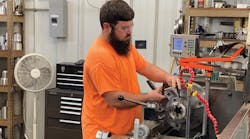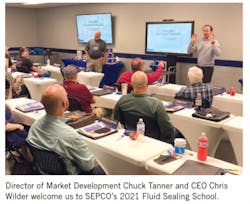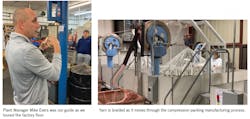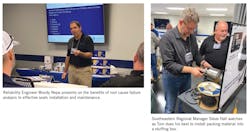Last November I had the rare chance to go back to school for a week, and jumped at the chance!
The program was Fluid Sealing School, a three-day course provided by SEPCO designed to introduce the basics of mechanical seals, air seals, and compression packing from manufacture and installation to maintenance and replacement. About 20 of us from across the United States headed to Alabaster, AL for a week to get grounded in these basics and, if possible, to get our hands a little dirty by installing some compression packing ourselves.
After breakfast the first morning and a warm welcome from CEO Chris Wilder, the class assembled for an extensive tour of the SEPCO plant. Key stops along the way included a wide variety of compression packing manufacturing steps, from braiding the yarn to labeling the product. In the words of Chuck Tanner, SEPCO’s director of market development, “compression packings are the oldest and still the most common sealing device used,” and selecting the right packing match for the application is key to sealing success.
Packing matches are based on several compatibility factors, including shaft speed, operating pressures and temperatures, and the product being sealed (especially the pH of the product, and whether the product includes solids). For example, the packing used with higher shaft-speed applications commonly is black, as the yarn is graphite-infused to enable more efficient heat transfer when the machine is operating. Overall, Tanner said, the factors that contribute to good stuffing box reliability include: (1) yarn fiber compatibility with application requirements; (2) precise installation; and (3) high standards in the maintenance and reliability of equipment.
And, at the end of the first day, I got to experience what sealing technicians go through pretty much every day: the SEPCO team wheeled out some training stations, and the entire class was able to get hands-on experience in installing compression packing into a sample stuffing box, checking our work, and then removing the packing material so the next student could take a swing at it.
Other sessions during the school week covered both air seals and mechanical seals, and sealing for efficiency and water savings. The air seal is a non-contact seal that allows for shaft movement; for example, when new material is added to a mixer, and the shaft gets bumped a bit, the air seal uses an air cushion to keep the shaft aligned and in place without the seal damaging the housing. As for mechanical seals, usually these seals are deployed based on environmental factors or harsh environments. These seals can be run with slurry applications, as the seal materials can handle the abrasives, and seal faces must be kept cool and clean for successful operation. (Hot water has no lubricating properties and will turn to steam in a series of micro-explosions, which will start to wear away the seal face.) Also, the class session on water savings was so full of good information that SEPCO regional manager David Brewer agreed to turn it into a new article for Plant Services.
Finally, from a maintenance and reliability perspective, SEPCO reliability engineer Woody Nepa delivered a session on root cause failure analysis of fluid sealing applications. Nepa observed that all failures belong to one or more of the following seven categories – design, materials, manufacturing, application, installation, operation, and maintenance – and recommended that maintenance technicians follow the Deming cycle of plan-do-check-act as part of their RCFA problem-solving sequence.
The bottom line, said Nepa, is that it’s rare that it’s just one factor that causes a failure; it’s usually two or three factors that are stacked on each other, so it’s worth uncovering the failure modes to ensure top asset health.
After a celebratory dinner at the end of the second day and a final Q&A session the next morning, the SEPCO team wrapped up our school week. It was a terrific opportunity to learn new skills and brush up on old ones, and gain a deeper understanding of the ways that fluid sealing contribute to overall asset health and reliability.
This story originally appeared in the February 2022 issue of Plant Services. Subscribe to Plant Services here.
This article is part of our monthly Your Space column. Read more from our Your Space series.






